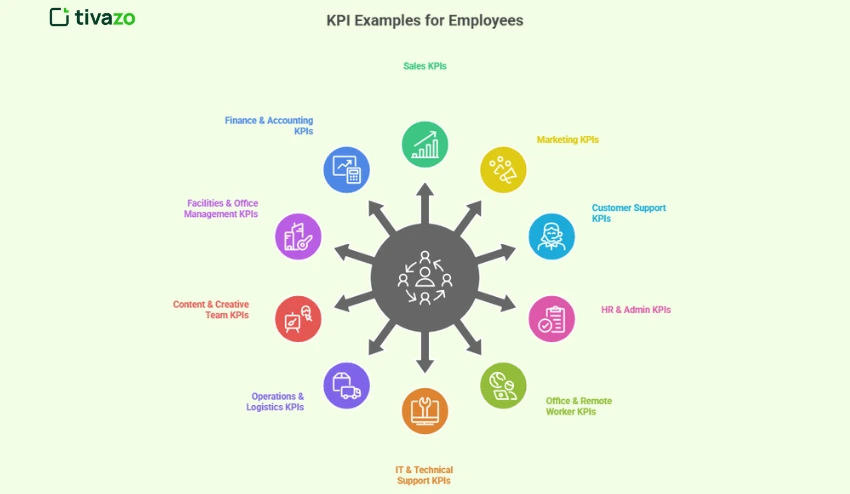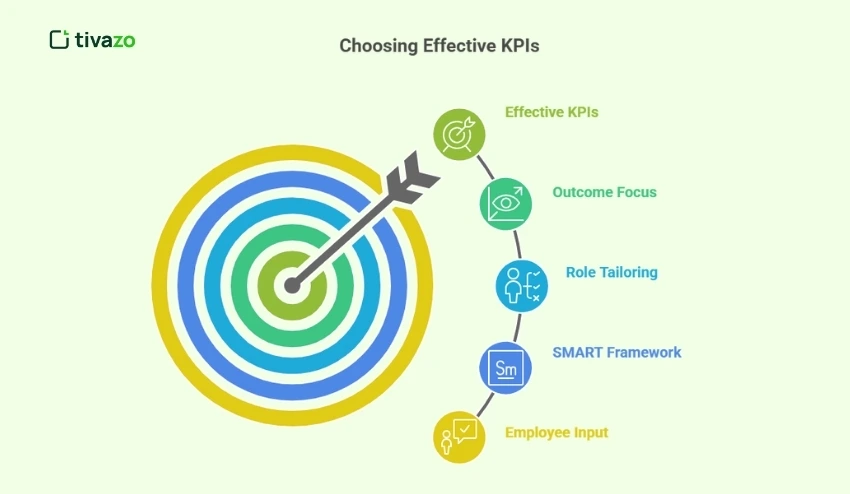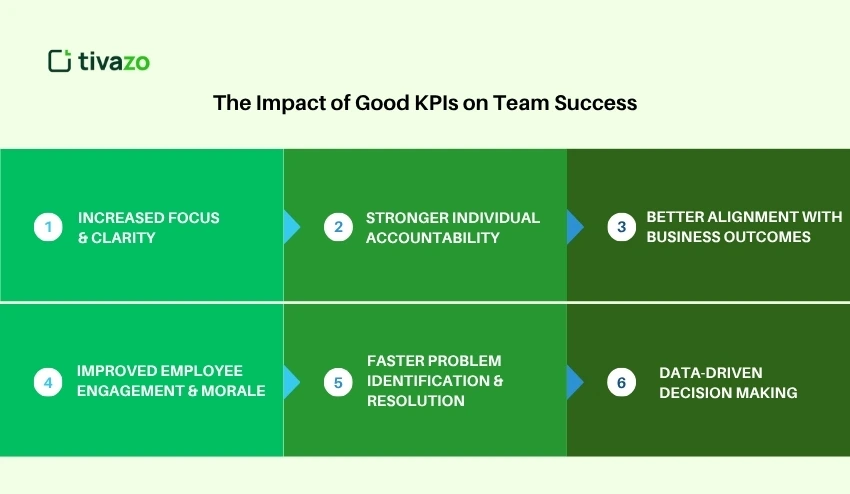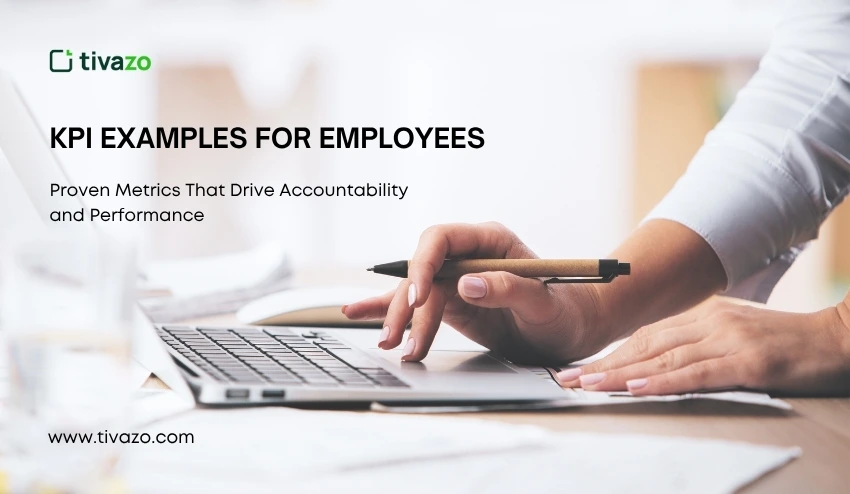In today’s fast-moving business environment, clarity is the key to success. Whether you lead an office team, remotely working staff, or individual contributors, establishing appropriate Key Performance Indicators (KPIs) is vital to direct employee performance and fulfill business objectives. KPIs provide a clear measurement framework that allows us to assess progress, keep employees accountable, and connect their work to the company’s core purpose.
Many organizations struggle with using KPIs because they often design KPIs too broadly, too complicated, or lack a meaningful connection to an individual’s actual job duties. This can cause confusion and disengagement that moves KPIs beyond being performance enhancers.
This guide is designed to solve that problem. We’ll start by exploring KPI examples for employees that move the needle. You will learn what KPIs are – true employee performance metrics, not vanity numbers – as well as how to design KPIs that resonate with employees. Plus, discover key performance indicators for staff and how to measure employee performance effectively. The guide includes 10 compelling KPI examples for multiple jobs, and useful templates and tools to help measure with accuracy. You will also learn how to avoid common mistakes when designing KPIs, and even see some unique approaches to KPIs for remote teams and collaborative goal setting.
In the end, you will have a meaningful plan to create and manage KPIs that help to genuinely advance employee performance and your business goals.
Key Highlights:
- What are KPIs
- Best KPI Examples for Employees
- Measure Employee Performance Using KPIs
- Choose the Right KPIs for Your Team
- Common KPI Mistakes to Avoid
- Impact of Good KPIs on Team Success
What Are KPIs? (And Why Employees Need Them)
A KPI (or Key Performance Indicator) is a measurable value that forms the core of any employee performance metrics strategy—how an individual is performing and meeting specific goals based on their job. To clarify, a KPI is the speedometer for an employee’s performance because it gives clear, measurable ways for measuring progress, acknowledging accomplishments, and discovering issues before they turn into critical problems. The how of work is merely a list of tasks, yet the outcome and value are represented by the results achieved.
Keep in mind that a KPI is often confused with an OKR (Objectives and Key Results). OKRs can set a higher level of desired change/direction, while KPIs are less abstract and are firm performance indicators of progress toward the OKR. KPIs are valuable because they provide clarity on success; provide employees clarity on the objectives of the company and how their work contributes towards meeting or exceeding those objectives; employees can track their progress in monitoring their trajectory; and at the end of the year, there are tangible measures of fair and equitable performance management!.
KPIs provide transparency and accountability, which support each employee and the organization as a whole to achieve shared individual and company success. Now let’s look at real KPI examples for employees by role.
10 Best KPI Examples for Employees (Role-Based)
Now we are going from theory to practice. These are actionable, demonstrated KPIs for major employee roles customized to align with what matters.

1. Sales KPIs
Monthly Revenue Generated is one of the clearest measures of sales success, tracking the total dollar amount by a salesperson or team in a month. Meet your KPI examples for employees in sales.. It helps input as organizations measure if sales performance targets are created as a company, and the sales team’s contribution to the overall growth of the business.
The Lead-to-Customer Conversion Rate highlights how effective the team is at converting leads to customers, which describes how well the sales process is working and whether they are building relationships and closing deals. Finally, the Average Deal Size tracks the average revenue made on the sale, showing what pricing and product strategies performed as well as pointing to whether sellers are focused on high-value deals or volume sales.
2. Marketing KPIs
Top employee performance metrics for your marketing team. Marketing is typically a function of visibility, with a focus on attracting, engaging, and eventually converting the right audience, and the right KPIs allow marketers to measure their success quantitatively. Website Traffic from Campaigns measures visitors to your website derived from marketing activity, showing the campaigns that yield the most interest from potential customers.
Email Open Rate tells marketers how many recipients opened the marketing email, allowing for considerations of the effectiveness of the subject lines and whether the audience engaged with the message. Lastly, Content Engagement Score is the aggregate of shares, likes, comments, and time spent on content, which allows marketers to understand if their content is suitable to drive engagement and interest from the audience.
3. Customer Support KPIs
When evaluating customer service, speed and customer satisfaction reign supreme essential key performance indicators for staff in support. Tickets Resolved per Day measures how productive an agent’s work is based on the number of support requests they can close that day and provides a sense of how quickly customers can access and receive help.
First Response Time metric is significant for customer support interactions because customers want a speedy acknowledgement that their support request is received; quicker acknowledgement of a ticket will lead to more positive customer experiences. The Customer Satisfaction Score (CSAT) is the ultimate measure of how happy a customer is regarding the support they receive in response to a support request, typically measured through a survey after the issue has been resolved; it is one of the most important measurement metrics of service quality.
4. HR & Admin KPIs
HR capacity is about attracting, recruiting, and retaining talent critical to measuring employee performance in HR. The Time to Hire metric measures how long it takes to fill open positions; in general, a shorter hiring process means less downtime and lower costs. The Employee Retention Rate shows the percentage of employees who remain employed in the organization over time; it indicates satisfaction with the workplace and relative stability of the organization.
Low retention rates can indicate substandard culture or management. The Onboarding Completion Rate measures how many new hires complete onboarding and training programs; this is important since orientation is designed to set up new hires for success as quickly as possible and to reduce early turnover.
5. Office & Remote Worker KPIs
For office and to a lesser degree, remote employees, tracking productivity and levels of engagement is very important, as universal KPI examples for employees across any setting. The Task Completion Rate measures how many assigned tasks employees finish on time; thereby determining how efficiently, timely, and focused they can process employee work assignments at work.
The Collaboration Score designates how well team members meet formally or informally, provide semi-regular status updates relative to their scopes of responsibilities, and how effectively they are in working towards broader team goals. An effective boot camp could also be minimized if cultural players in the employee’s organization were a barrier; therefore, it is important to measure collaboration and team engagement at this level.
The remoteness of work can create walls or barriers to communication. Punctuality & Attendance is tracked to capture variation in consistent presence and punctuality; establishing reliable team members asks much more than just being present; it relies on consistent punctuality for normal employment interactions in daily work deadlines and timelines that teams need to coordinate on.
6. IT & Technical Support KPIs
The technology departments ensure the day-to-day operations run as smoothly as possible with these employee performance metrics. System Uptime Percentage takes a general look at how much time over a period of time the IT systems are operational and not down from failure.
The higher the uptime percentage is, the less time employees and customers are disrupted. Mean Time to Repair (MTTR) calculates the average time to repair problems with IT. The lower the MTTR, the better the quality of support and efficiency in resolving issues.
The total number of Support Tickets Closed tells us how much work is being performed and the productivity of the technology departments by periods, stepped over a year, month-to-month, or quarter by quarter, to see how many technical problems are being resolved in a period of time.
7. Operations & Logistics KPIs
Effective Operations are the foundation of deliveries and fulfilment of our KPI examples for employees in operations. Order Fulfillment Time measures how fast customers’ orders are received, processed, and shipped. The faster the order fulfillment, the better the customer experience and repeat ordering.
Inventory Accuracy checks operational efficiencies, whether stock records are consistent with what is available in warehouses and retail outlets. If there is no consistency, it may lead to false overstocking or stock-outs that harm revenue. The cost per shipment measures the total cost of packaging, shipping, handling, and sometimes even freight to areas to restore shipment profitability, while optimizing logistics for the organization.
8. Content & Creative Team KPIs
Creatives build brand awareness, so they create materials for campaigns, vital key performance indicators for staff in creative roles. Content Production Volume is a count of content they created within a period (blog posts, videos, graphic titles) to determine the total capacity of output.
Engagement Rate is how audiences interact with their content, through likes, comments, or shares. This helps the team determine how effective their content was and how connected to their audience. Project Completion Time is an indicator of how quickly creative projects are finished, which is important for deadlines and balancing project workflows.
9. Facilities & Office Management KPIs
Facilities teams keep the workplace safe and operational, top how to measure employee performance in facilities. Maintenance Request Response Time captures the amount of time a reported item has been resolved. The quicker response time provides comfort to employees within the workplace while making the workplace a safe environment. The Facility Utilization Rate is used to see how well we are using the office space, for decisions about space planning and saving costs. Safety Incident Frequency indicates the number of workplace accidents, hazards, injuries, etc. Fewer incidents demonstrate a safer working environment and positive safety culture.
10. Finance & Accounting KPIs
The role of finance is to ensure the health of the company and manage ongoing compliance, core employee performance metrics for finance teams. The Accuracy of Financial Reports KPI measures the accuracy of accounting statements, which is crucial not just for making informed business decisions but also for compliance with regulatory requirements. Days Sales Outstanding (DSO) measures the average number of days required to collect receivables after sales have been made. Effectively measuring and managing DSO controls the flow of cash and liquidity. A lower DSO means that a company is improving its ability to collect receivables and ultimately providing a more stable financial position.
How to Measure Employee Performance Using KPIs
Measuring employee performance metrics using KPIs is not simply counting the number; it has to do with converting it into information that will increase the potential to help make a better decision. There is more than one way to keep track of how to measure KPIs. Some organizations feel that just using spreadsheets or forms for current metric tracking works best for them, particularly for smaller teams. Today, many organizations utilize automated tools to cut down the time spent on data collection and have real-time visibility. There are also performance review tools like BambooHR or Lattice that can obtain KPI information during employees’ performance evaluations.
Using more than one tool can be beneficial at times if you want to make sure every aspect of information is captured. I advise you to keep track of KPI measurement and have the team review team KPIs weekly, while individual KPIs can be assessed every month. Weekly touchpoints create continuity and momentum towards achieving KPIs, while a month-long period allows for more in-depth thinking and reflection rather than just reacting to a colored highlighted spreadsheet. Combining quantitative parts of the task, like sales numbers and task completions, with qualitative data from feedback builds a more rounded view of performance.
Finally, I would suggest having employees continually participate in the reflection portion of KPIs and altering goals both as a collaborative effort and an ongoing process. KPI Measurement should be seen as a collaborative process rather than merely an employee’s KPI report and evaluation.
How to Choose the Right KPIs for Your Team
There is no easy way to determine the right KPIs. What works for a sales rep does not necessarily work for a designer.

- Tailor KPIs to Each Role
The KPIs should reflect the expectations of each position, which can be different for a sales rep than a designer. A one-size-fits-all KPI would create confusion and deliver poor results. - Use the SMART Framework
KPIs have to be prospective, meaning Specific (clear and focused), Measurable (backed by data and can be quantified), Achievable (realistic and attainable), Relevant (connected to your business), and Time-bound (has a due date). Using the SMART method will help you find KPIs that you can act on, and the KPIs will mean something. - Limit the Number of KPIs
Having too many KPIs only confuses employees and spreads their focus while trying to complete work. For each role, it would be best to stick to 3-5 key metrics to help keep your employees focused and manageable. - Avoid Vanity Metrics
Don’t choose KPIs just because they look good on paper (looking at you, social media likes). Choose the KPIs that move the needle on your business, such as sales conversion rate and customer satisfaction. - Focus on Outcomes, Not Just Activities
KPIs should measure results, not just tasks. For example, tracking “number of calls made” isn’t as useful as tracking “number of deals closed” because outcomes drive success. - Include Employee Input
Involving employees in setting their KPIs increases ownership and motivation. When people help define what success looks like, they’re more likely to stay committed and perform better.
Common KPI Mistakes to Avoid (And What to Do Instead)
Let’s fix what most teams get wrong. Avoid these slip‑ups when defining KPI examples for employees
| Mistake | What to Do Instead |
|---|---|
| Too many KPIs | Focus on 3–5 that really move the needle |
| Tracking only activities | Measure impact (e.g., “calls” vs. “converted leads”) |
| No employee input | Co-create KPIs for better engagement |
| KPIs never reviewed | Schedule monthly check-ins |
The Impact of Good KPIs on Team Success
Good KPIs do more than assess performance; they create momentum.

- Increased Focus & Clarity
Good KPIs clarify expectations for teams so everyone knows where to focus their energy and efforts. - Stronger Individual Accountability
With clarity around KPIs, each team member can take ownership of their outcomes and therefore be more accountable for their performance. - Better Alignment with Business Outcomes
KPIs create an explicit link between individual and team goals and the company’s overall objectives, allowing all employees to head in the same direction. - Improved Employee Engagement & Morale
Good, clarified KPIs help engage employees by demonstrating progress and achievement, which results in greater job satisfaction and team spirit. - Faster Problem Identification & Resolution
Good KPIs pinpoint problems early, allowing teams to tackle challenging situations early and speedily, before they become overwhelming. - Data-Driven Decision Making
When managers have data from their KPIs, they can make good decisions to improve processes, resource allocation, and performance.
How to Involve Employees in Their KPI Setting
Involving employees in the process of developing their KPIs is far more likely to elicit a commitment to achieving those goals. Instead of mandating KPIs by imposing metrics from the top down, encourage KPI development to be a conversation where employees have the opportunity to express their take on what success looks like in their role, etc.
This conversation could be furthered by incorporating benchmarks of peer performance, as well as expectations from managers, to ensure the KPIs will be realistic and aligned with the team’s goals. By consulting employees in developing their goals, they will trust that the goals reflect their input and have a greater sense of ownership, greater accountability, and will work even harder to perform well. Involving employees in goal development creates a positive feedback loop whereby the employees aren’t just operationalising targets, they are inspired to overperform because they were part of their pathway to success!
Final Thoughts: Set KPIs That Inspire, Not Intimidate
KPIs remind us that these performance indicators are not intended to dominate or scare employees; they are intended to create clarity, signal next steps, and set the stage for growth. The best KPIs are set together with employees rather than on them, which creates a feeling of ownership that translates into motivation.
When applied appropriately, the data from KPIs provides individuals and teams with opportunities to enhance and succeed rather than serve as a measure of punishment or enforcement. Simple and focused KPIs alleviate confusion and frustration and keep everyone organized and progressing together. Armed with the right employee performance metrics, your KPI examples for employees will fuel growth, not confusion. If you’re ready to turn your team’s goals into outcomes and have an effective way of tracking, managing, and aligning KPIs, tools can help you be efficient and make the work stand out as real performance.
FAQs
What is a good KPI example?
A good example is “Customer Satisfaction Score” for a support agent or “Leads Generated” for a marketer.
How do you evaluate employee performance using KPIs?
Track KPI progress over time using tools or dashboards, compare against goals, and hold regular reviews to evaluate effectiveness.
How many KPIs should an employee have?
Ideally 3–5. Too many dilute focus; too few lack direction.
Can KPIs improve productivity?
Yes. Clear KPIs give employees focus, purpose, and measurable direction—driving better output and engagement.




